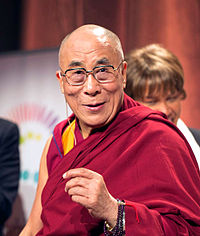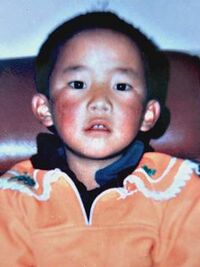Leaders of Tibetan Buddhism
Leaders of Tibetan Buddhism are found among the many different schools and lineages. The most prominent leaders are the Dalai Lama and the heads of the four schools of Tibetan Buddhism.
Historically, the Dalai Lamas have served as the political leaders of the Tibetan state, and they were also respected as spiritual leaders. But contrary to common misperceptions in the West, religious life in Tibetan Buddhism is not organized heirarchically. For example, unlike the Pope of the Catholic church, who appoints cardinals and bishops to run the affairs of the church, the Dalai Lama does not appoint the heads of monasteries, lineages, or other institutions. In addition, unlike the Pope, the Dalai Lama does not issue decrees or promulgate new teachings that other Buddhists are expected adopt.
The monastic institutions in Tibetan Buddhism are self-organized and depend for their support on their local community. They are usually associated with one of the main schools of Tibetan Buddhism. While all the major schools in Tibet share a core set of teachings, each school also includes a unique teaching lineage that is traced back to particular teachers.
Each of the major schools and lineages have their own unique methods for choosing their leaders. For example, the head of the Gelugpa school is appointed according to a merit-based system, and serves for a term of seven years. The head of the Nyingma school rotates between the leaders of the six Nyingma lineages, with a new head chosen every three years. The head of the Sakya school is traditionally a hereditary position. The head of the Karma Kagyu school, the Karmapa, is selected by finding the rebirth of the previous Karmapa.
Each of the main schools also have their own "study colleges" (shedras), where they train scholars following a curriculum particular to that school. Some scholars will train at more than one "study college", and hence become proficient in the teachings of multiple schools.
Non-hierarchal structure
Matheui Ricard writes:
...the Buddhist community is not organized in a hierarchical manner as, for example, in the Catholic Church, where priests must account for their behavior to the bishops, cardinals and eventually, at the top of the pyramid, to the Pope himself. Buddhist schools, as these have emerged in different countries are institutionally completely independent of each other. And even within the fold of Tibetan Buddhism, the patriarchs of the four principal schools—while being respected as spiritual authorities—do not intervene in the administration of the monasteries, which function as autonomous entities.
Among Tibetan masters, H.H. the XIVth Dalai Lama is clearly the object of unanimous respect. The teachings and advice that he gives may well be the source of profound inspiration but they are never regarded as commands. No authoritative body goes to check whether a given monastery actually implements his advice.[1]
Heads of the main schools of Tibetan Buddhism
Gelugpa school
The head of the Gelugpa school is given the title of Ganden Tripa. The Ganden Tripa is appointed to this position according to a merit-based system, and serves for a term of seven years.
Karma Kagyu school
The Karma Kagyu school is one of the main lineages within the Kagyu tradition. The head of this school is given the title of Karmapa. The Karmapa serves for life, and a new Karmapa is traditionally selected by finding the rebirth of the previous Karmapa.
Sakya school
The head of the Sakya school is given the title of Sakya Trizin. The Sakya school is unique, in that its head is chosen from a particular hereditary lineage, the descendants of the Khön family.
Nyingmapa school
The head of the Nyingma school rotates between the leaders of the six Nyingmapa lineages, with a new head chosen every three years.
The Nyingmapa school did not have an official leader prior to the formation of the Central Tibetan Administration (the Tibetan government in exile) in 1960. The position of the “Supreme Head” of the Nyingmapas was established at this time in order to represent the school within the Tibetan government-in-exile.
Bon tradition
The Bon tradition is a significant minority religion in Tibet, which shares many similarities with Tibetan Buddhism, but also has some distinctive beliefs. The Bon tradition is represented within the Tibetan government in exile by senior teachers within this tradition.
The role of the current Dalai Lama

The 14th Dalai Lama currently lives in exile in India. He has retired from a political role, but he still offers spiritual guidance to the Tibetan Buddhist community.
He is one of the teachers who has mastered the academic teachings of all the major Buddhist lineages in Tibet as well as carrying the transmissions for many practices from different schools that need to be passed on personally from teacher to pupil. He is however not unique in that respect.
The Dalai Lama is a lineage holder in the Gelugpa school, but he is not the head of this lineage. The head of the Gelugpa lineage is the Ganden Tripa.
The Panchen Lama

Together with the Dalai Lamas, the Panchen Lamas are the most important reincarnation lineage in the Gelugpa tradition.
Traditionally the Dalai Lamas are involved in the recognition and training of the Panchen Lamas, and the Panchen Lamas play a significant role in the recognition and training of the Dalai Lamas.
However, the Panchen Lama chosen by the 14th Dalai Lama and his delegation in Tibet, Gedhun Choekyi Nyima, was was forcibly disappeared by the Chinese government in 1995, when he was six years old. He has not been seen in public view since. After disappearing the Dalai Lama's selection for Panchen Lama, the Chinese government chose their own candidate, whom the Dalai Lama does not recognize.
In an interview from April 2018, the Dalai Lama said that according to reliable information Gedhun Choekyi Nyima is still alive and continuing a normal education. He also said of the Chinese selection, Gyancain Norbu, that he has studied well under the guidance of one good teacher. He also says that there can be more than one reincarnation of a lama - only one for the seat, but others that are also reincarnations.
References
- ↑ Matthieu Ricard (2017), A point of view